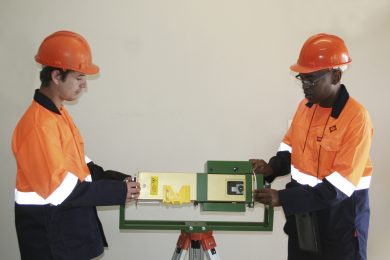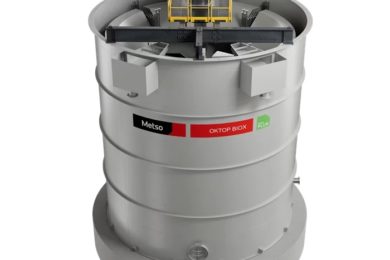With volatility in commodity prices, it is critical that mines optimise the operating costs of the entire plant, and this need has seen an increased focus on achieving the desired grind efficiency in mills. While each mill liner profile is designed to provide the correct trajectory to achieve either impact grinding or attrition grinding depending on the specific application, wear on the mill liner profile will affect the grind efficiency.
Matthew Fitzsimons, Technical Manager of Multotec Rubber, explains that it is important to understand that the wear rate of liners is not linear, and that as the liners wear the increased slippage of the charge increases the wear on the liners.
“This can, in turn, rapidly decrease the grind efficiency of the mill due to the trajectory in the mill being sub optimal and the energy transfer for breakage is reduced,” Fitzsimons says.
It is for this reason that condition monitoring of mill liners, whether steel or rubber, is necessary. Regular inspection of the liner profile will allow historical data to be collated which will facilitate liner life predictions.
Fitzsimons says the only way to approximate the trajectory is to measure the liner profile and this can only be done when the mill is stopped.
“The correct procedure is to determine the profile at installation and then again at each subsequent inspection. This will allow the determination of the profile and the analysis of the trajectory of the charge.”
Most plants focus on throughput, however there are some that, due to economic conditions, are forced to focus on cost savings. This data, together with critical mill operating parameters, is used to predict the point where the liner becomes inefficient and it is at this point that the mill itself will become inefficient.
“Depending on the accuracy of the information available, the plant can make a critical decision as to whether to run the liners to the changeout point or change when the liners reach this point of inefficiency,” Fitzsimons says.
Describing how liner inspection has been done traditionally, Fitzsimons says that until recently there have only been two options available, one of which is the pin gauge method which is known to be time consuming and often inaccurate. Furthermore it requires that the mill be stopped to allow access for personnel to actually perform the inspection. At the other of the scale is very expensive sophisticated technology.
“Inspection using the pin gauge method is done during planned downtime, however it is essential that skilled and trained technical personnel take an accurate measurement because once the mill has restarted it is not feasible to stop it again,” he says. “This method does not allow live feedback and it is not possible to verify the measurement immediately.”
Fitzsimons confirms that Multotec Rubber recently introduced what he says is set to become the most affordable best practice mill liner profile condition monitoring system because it offers such high accuracy and immediate availability of information as such a reasonable cost.
“With the introduction of MultoScan it is now possible for plants to accurately measure the liner profile and using this information end users can easily and accurately predict the lifespan of the liner and the point at which the mill will become inefficient,” he says. The automatic measurement and display of the charge level is valuable in confirming that the operation of the mill is correct and this value is essential in calculating the trajectory.
Highly skilled technicians take the data acquired by MultoScan and leverage Multotec’s Hawkeye proprietary programme to interpret and analyse the data.
Significantly there is no time lag on the information analysis and the level of responsiveness possible using MultoScan has not been available to plants until now.
“It will allow customers immediate feedback on the condition of the liners and any immediate issues can be addressed on the spot,” Fitzsimons says.
Another very important advantage when using MultoScan is the repeatability of the results. This is considered an enormous benefit as there is virtually no room for human error.
In addition, MultoScan will allow plants to reduce the time spent in the mill taking readings and this will decrease the mill stoppage time, another significant cost saving for mines.
Having access to accurate information on the liner profile will allow maintenance crews to set the trigger point for the liner inventory. This will, in turn, allow plants to reduce the liner stockholding drastically optimising the inventory; another cost saving.
Fitzsimons explains that MultoScan has been proven in field trials in some of the most arduous milling conditions on the African continent and most recently the technology has been exported to Australia.
“The potential that MultoScan offers is enormous. Using key operating criteria on individual plants it will be possible to map mill key performance indicators versus the liner profile. This extends the capability of the condition monitoring system and will allow mines to select specific key criteria,” Fitzsimons says.
“Multotec Rubber is the only rubber liner manufacturer that has its own in-house condition monitoring system and by improving the way liners were traditionally monitored we will be able to take condition monitoring to the next level,” he continues.
“By having access to this level of input and technical assistance plants will be able to optimise mill performance,” Fitzsimons concludes.









